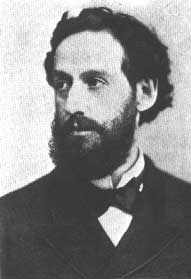Ernst von Fleischl-Marxow facts for kids
Ernst von Fleischl-Marxow was an important Austrian scientist. He was born in Vienna on August 5, 1846, and passed away there on October 22, 1891. Ernst was a physician and a physiologist. He was famous for studying how nerves and the brain use electricity. He also invented many new tools that were used in hospitals and for science research.
Contents
Early Life and Family
Ernst was born as Ernst Fleischl. His father was Karl Fleischl and his mother was Ida Marx. In 1875, the Emperor Franz Joseph gave Karl Fleischl a special title. He became "Edler von Marxow." This meant his family was part of the Austrian nobility. So, Ernst's full name became Ernst Fleischl Edler von Marxow. He usually used the shorter name, Ernst von Fleischl-Marxow.
His Journey to Science
Ernst von Fleischl-Marxow studied medicine at the University of Vienna in Austria. He started working as a helper in a science lab with Ernst Wilhelm von Brücke. Later, he worked with a famous doctor named Carl von Rokitansky.
However, Ernst had an accident. While working with a cadaver (a body used for study), he hurt his thumb. It got infected, and he had to have it removed. This meant he could no longer work in the same way with bodies. So, he decided to focus on physiology, which is the study of how living things work.
He went back to von Brücke's lab in Vienna. Before that, he spent a year studying with another famous physiologist, Carl Ludwig, at the University of Leipzig in Germany. Ernst earned his medical degree in 1874.
Discovering Brain Electricity
In his early career, Fleischl-Marxow studied the electrical signals in nerves and muscles. This was a new and exciting field. Scientists like Emil du Bois-Reymond had already found that nerves use electrical signals called action potentials.
This field grew a lot because of new tools from physics. These tools could measure very tiny amounts of electricity. Living tissues have very small electrical signals, so scientists needed special devices. Fleischl-Marxow was good at physics. He invented tools like the reonome, which helped control electrical signals. He also improved a device called the Lippmann electrometer to measure tiny electrical changes in living things.
Around 1876, Fleischl-Marxow started looking at the overall electrical activity of the brain. Scientists knew the brain was made of cells called neurons. They thought these cells might also have electrical activity. But it was hard to measure because many small signals cancel each other out.
Even so, Fleischl-Marxow was the first to show that when you see or hear something, it creates small electrical changes on the surface of the cerebral cortex (the outer part of the brain). These changes were linked to what the senses picked up.
Oddly, Fleischl-Marxow did not publish his findings right away. He put them in a bank safe and said they should only be revealed in 1883. Meanwhile, other scientists like Richard Caton in Great Britain and Adolf Beck in Poland also found similar things. They published their work, which led to the discovery of the electroencephalogram (EEG), a way to record brain waves.
Later Research and Inventions
In 1880, Fleischl-Marxow became a full professor at the University of Vienna. He also became a member of the Austrian Academy of Sciences. He studied how the optic nerve works in the retina (the back of the eye) and the properties of the cornea (the clear front part of the eye).
Using his knowledge of optics, he created several tools for measurement. One was a spectropolarimeter. Another was a hematometer, which measured the amount of hemoglobin (a substance that carries oxygen) in the blood. This device was named after him and was used for many years in hospitals and labs.
Friendship with Sigmund Freud
For many years, Fleischl-Marxow suffered from pain because of his amputation. Sigmund Freud, a famous doctor who studied the mind, was one of his closest friends. Freud admired him greatly, saying he was a very talented and intelligent person.
Ernst von Fleischl-Marxow passed away on October 22, 1891, when he was 45 years old.


